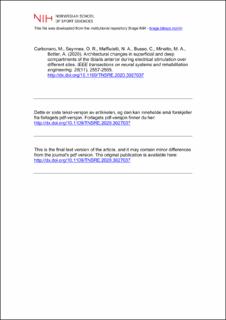| dc.contributor.author | Carbonaro, Marco | |
| dc.contributor.author | Seynnes, Olivier R. | |
| dc.contributor.author | Maffiuletti, Nicola A. | |
| dc.contributor.author | Busso, Chiara | |
| dc.contributor.author | Minetto, Marco Alessandro | |
| dc.contributor.author | Botter, Alberto | |
| dc.date.accessioned | 2021-08-30T11:00:35Z | |
| dc.date.available | 2021-08-30T11:00:35Z | |
| dc.date.created | 2020-12-17T12:41:38Z | |
| dc.date.issued | 2020 | |
| dc.identifier.citation | IEEE transactions on neural systems and rehabilitation engineering. 2020, 28(11), 2557-2565. | en_US |
| dc.identifier.issn | 1534-4320 | |
| dc.identifier.uri | https://hdl.handle.net/11250/2771748 | |
| dc.description | Dette er siste tekst-versjon av artikkelen, og den kan inneholde små forskjeller fra forlagets pdf-versjon. Forlagets pdf-versjon finner du her: https://doi.org/doi.org/10.1109/TNSRE.2020.3027037 / This is the final text version of the article, and it may contain minor differences from the journal's pdf version. The original publication is available here: https://doi.org/doi.org/10.1109/TNSRE.2020.3027037 | en_US |
| dc.description.abstract | Electrical stimulation is widely used in rehabilitation to prevent muscle weakness and to assist the functional recovery of neural deficits. Its application is however limited by the rapid development of muscle fatigue due to the non-physiological motor unit (MU) recruitment. This issue can be mitigated by interleaving muscle belly (mStim) and nerve stimulation (nStim) to distribute the temporal recruitment among different MU groups. To be effective, this approach requires the two stimulation modalities to activate minimally-overlapped groups of MUs. In this manuscript, we investigated spatial differences between mStim and nStim MU recruitment through the study of architectural changes of superficial and deep compartments of tibialis anterior (TA). We used ultrasound imaging to measure variations in muscle thickness, pennation angle, and fiber length during mStim, nStim, and voluntary (Vol) contractions at 15% and 25% of the maximal force. For both contraction levels, architectural changes induced by nStim in the deep and superficial compartments were similar to those observed during Vol. Instead, during mStim superficial fascicles underwent a greater change compared to those observed during nStim and Vol, both in absolute magnitude and in their relative differences between compartments. These observations suggest that nStim results in a distributed MU recruitment over the entire muscle volume, similarly to Vol, whereas mStim preferentially activates the superficial muscle layer. The diversity between spatial recruitment of nStim and mStim suggests the involvement of different MU populations, which justifies strategies based on interleaved nerve/muscle stimulation to reduce muscle fatigue during electrically-induced contractions of TA. | en_US |
| dc.language.iso | eng | en_US |
| dc.subject | electric stimulation | en_US |
| dc.subject | electromyography | en_US |
| dc.subject | humans | en_US |
| dc.subject | muscle contraction | en_US |
| dc.subject | muscle fatigue | en_US |
| dc.subject | muscle | en_US |
| dc.subject | skeletal | en_US |
| dc.subject | recruitment | en_US |
| dc.subject | neurophysiological | en_US |
| dc.subject | ultrasonography | en_US |
| dc.title | Architectural changes in superficial and deep compartments of the tibialis anterior during electrical stimulation over different sites | en_US |
| dc.type | Peer reviewed | en_US |
| dc.type | Journal article | en_US |
| dc.description.version | acceptedVersion | en_US |
| dc.source.pagenumber | 2557-2565 | en_US |
| dc.source.volume | 28 | en_US |
| dc.source.journal | IEEE transactions on neural systems and rehabilitation engineering | en_US |
| dc.source.issue | 11 | en_US |
| dc.identifier.doi | 10.1109/TNSRE.2020.3027037 | |
| dc.identifier.cristin | 1861039 | |
| dc.description.localcode | Institutt for fysisk prestasjonsevne / Department of Physical Performance | en_US |
| cristin.ispublished | true | |
| cristin.fulltext | postprint | |
| cristin.qualitycode | 2 | |
